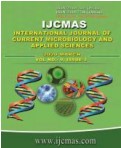


 National Academy of Agricultural Sciences (NAAS)
National Academy of Agricultural Sciences (NAAS)

|
PRINT ISSN : 2319-7692
Online ISSN : 2319-7706 Issues : 12 per year Publisher : Excellent Publishers Email : editorijcmas@gmail.com / submit@ijcmas.com Editor-in-chief: Dr.M.Prakash Index Copernicus ICV 2018: 95.39 NAAS RATING 2020: 5.38 |
Oysters (Crassostrea gasar) are globally important but highly susceptible to microbial hazards. Critical control points (CCPs) for oyster safety involving 10 ppm calcium hypochlorite Ca(OCl)2, storage temperatures and traditional postharvest practices were employed. Microbiological and physico-chemical characteristics were analyzed. Un-iced storage (27-35oC) resulted in significant total viable counts (TVCs) exceeding recommended limits (approx. 5 log10 cfu/g). Diverse microbial profiles and hazardous levels occurred in traditionally handled samples compared to Ca(OCl)2 treated samples. Regardless of Ca(OCl)2 application, significant microbial populations (5.28 log10 cfu/g and 6.43 log10 cfu/g) and undesirable pH (<6.30) and trimethylamine contents of 37.65 and 45.84 mgN/100g were occasioned by 27-35oC storage. The preponderance of pathogenic Gram positive organisms (Bacillus and Staphylococcus spp.) occurred in 27-350C stored samples irrespective of Ca(OCl)2 application. A remarkable increase in Gram positive flora to Gram negative profile ratio of approximately 5-fold occurred in 4-60C stored samples versus 27-350C stored samples; underscoring the impacts of storage temperature. These clearly demonstrate the critical role of storage temperature in spite of other CCPs employed. Overall, the need for adoption of CCPs has been demonstrated indicating that cold-chain practice is necessary to enhance microbial safety of oyster and maximize its local and international trade.
 |
 |
 |
 |
 |